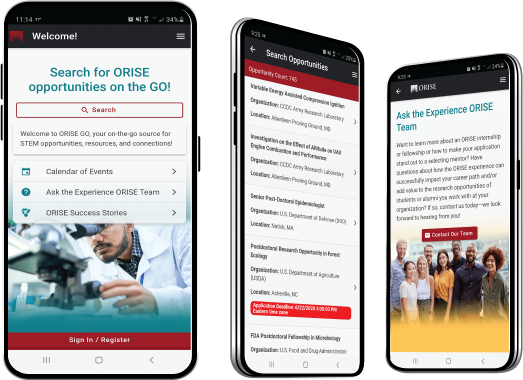EPA Modeling Transport of Particulate Pollution Research Opportunity
Connect with ORISE...on the GO! Download the new ORISE GO mobile app in the Apple App Store or Google Play Store to help you stay engaged, connected, and informed during your ORISE experience and beyond!
-
An application
-
Transcript(s) – For this opportunity, an unofficial transcript or copy of the student academic records printed by the applicant or by academic advisors from internal institution systems may be submitted. All transcripts must be in English or include an official English translation. Click here for detailed information about acceptable transcripts.
-
A current resume/CV, including academic history, employment history, relevant experiences, and publication list
-
Two educational or professional recommendations. Click here for detailed information about recommendations.
*Applications may be reviewed on a rolling-basis and this posting could close before the deadline. Click here for information about the selection process.
EPA Office/Lab and Location: A research opportunity is available at the Environmental Protection Agency (EPA), Office of Research and Development (ORD), Center for Environmental Measurement and Modeling (CEMM), Atmospheric and Environmental Systems Modeling Division (AESMD) located in Research Triangle Park, North Carolina.
Research Project: During cold and dark wintertime conditions, areas across the United States face serious particulate pollution problems, with increased violations of the National Ambient Air Quality Standards (NAAQS) set to protect human health. In Fairbanks, AK, for example, particulate matter (PM) is dominated by carbon compounds and sulfate, and these species can originate from both primary (i.e., directly emitted) and secondary (i.e., chemically formed in the atmosphere) sources. High wintertime PM concentrations can result from a combination of meteorology, chemistry, and emissions, but there remain uncertainties surrounding these high PM episodes and the best approaches to mitigate the problem. Although the sources and chemical species that dominate contributions to high PM vary throughout the nation, some features including cold temperatures, concentrated pollution layers, and increased wood combustion are common.
In order to understand the evolution of chemicals in the atmosphere (and design effective control strategies for those species that may pose a threat to human and ecosystem health), three-dimensional chemical transport models (CTMs) are often used. The Community Multiscale Air Quality (CMAQ) modeling system, developed and maintained by the U.S. Environmental Protection Agency (EPA), is a state-of-the-science CTM widely used in both regulatory and research applications.
In this proposed research project, the research participant will collaborate with a multidisciplinary team to understand the high wintertime PM problem in the U.S. The research participant may investigate potential pathways to particulate sulfur, nitrate, ammonium, and organic formation in the atmosphere, with a focus on those pathways that might be relevant in cold, dark wintertime conditions. This may include performing box modeling to determine promising pathways prior to implementation in CMAQ.
-
Chemical transport modeling, particularly the development and application of CMAQ
-
Atmospheric heterogeneous sulfur chemistry
-
Atmospheric ammonium nitrate formation in the wintertime
-
Atmospheric organic aerosol partitioning and multigenerational aging
-
Effectively conducting research both independently and within a diverse team of researchers
Learning Objectives: The research participant will have the opportunity to gain experience applying instrumented versions of CMAQ with additional diagnostic capabilities like the Sulfur Tracking Method (STM), Process Analysis (PA), and the Integrated Source Apportionment Method (ISAM). The research participant may also learn how CMAQ simulates wintertime episodes, how to design sensitivity simulations, and how to analyze the impacts of model developments.
The research participant will have the opportunity to present their research through a combination of reports and technical presentations. The research conducted may also contribute to a manuscript for submission to a peer-reviewed journal.
Mentor(s): The mentor for this opportunity is Kathleen Fahey (fahey.kathleen@epa.gov). If you have questions about the nature of the research please contact the mentor(s).
Anticipated Appointment Start Date: January 2021. All start dates are flexible and vary depending on numerous factors. Click here for detailed information about start dates.
Appointment Length: The appointment will initially be for one year and may be renewed three to four additional years upon EPA recommendation and subject to availability of funding.
Level of Participation: The appointment is full-time.
Participant Stipend: The participant will receive a monthly stipend commensurate with educational level and experience. Click here for detailed information about full-time stipends.
EPA Security Clearance: Completion of a successful background investigation by the Office of Personnel Management (OPM) is required for an applicant to be on-boarded at EPA.
ORISE Information: This program, administered by ORAU through its contract with the U.S. Department of Energy (DOE) to manage the Oak Ridge Institute for Science and Education (ORISE), was established through an interagency agreement between DOE and EPA. Participants do not become employees of EPA, DOE or the program administrator, and there are no employment-related benefits. Proof of health insurance is required for participation in this program. Health insurance can be obtained through ORISE.
Questions: Please see the FAQ section of our website. After reading, if you have additional questions about the application process please email EPArpp@orau.org and include the reference code for this opportunity.
The qualified candidate should have received a bachelor's, master's or doctoral degree in one of the relevant fields. Degree must have been received within five years of the appointment start date.
- Experience with Fortran and scripting
- Experience working with Linux
- Some knowledge of atmospheric chemistry and physics, especially aqueous chemistry in aerosol and clouds and gas-particle partitioning
- Citizenship: U.S. Citizen Only
- Degree: Bachelor's Degree, Master's Degree, or Doctoral Degree received within the last 60 months or anticipated to be received by 12/31/2020 11:59:00 PM.
- Discipline(s):
- Veteran Status: Veterans Preference, degree received within the last 120 month(s).

 ORISE GO
ORISE GO

The ORISE GO mobile app helps you stay engaged, connected and informed during your ORISE experience – from application, to offer, through your appointment and even as an ORISE alum!





